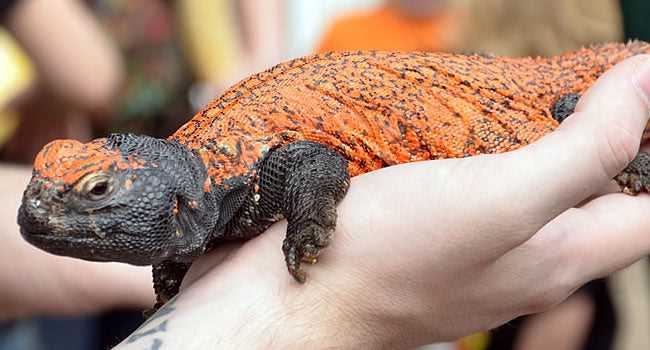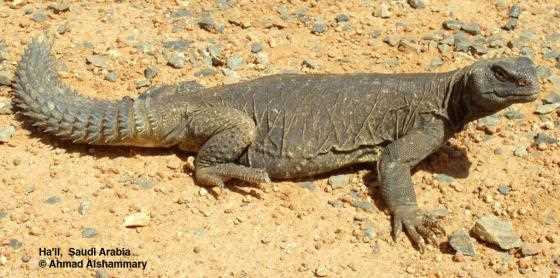
There are several types of uromastyx, each with its own unique characteristics and care requirements. The most commonly known species include Uromastyx aegyptia, Uromastyx ornata, Uromastyx geyri, and Uromastyx acanthinura. Each type varies in size, coloration, and personality, making them a popular choice among reptile enthusiasts.
What Are Uromastyx Lizards?
Uromastyx lizards have a robust and heavily armored body, with spiny scales covering their entire body, including their tails. These scales act as protection against predators and the harsh desert environment they inhabit. They have a triangular-shaped head and a long, muscular tail, which they use for balance and defense.
One of the most distinctive features of Uromastyx lizards is their ability to store fat in their tails. This adaptation allows them to survive in the harsh desert environment where food and water may be scarce. They can go for long periods without eating or drinking by utilizing the fat reserves stored in their tails.
There are various species of Uromastyx lizards, each with different colors and patterns. Some species have vibrant yellow, orange, or red scales, while others have more subdued colors like gray or brown. The coloration of these lizards helps them blend into their natural surroundings, providing camouflage and protection.
Uromastyx lizards are herbivorous, feeding primarily on a diet of plants, flowers, and leaves. They have a specialized digestive system that allows them to efficiently process tough plant material. This diet consists of a variety of desert vegetation, including cacti, succulents, and grasses.
Overall, Uromastyx lizards are fascinating reptiles that have adapted to survive in extreme desert conditions. Their unique appearance, behaviors, and dietary habits make them a captivating species to study and observe.
1. Species Variety
The Uromastyx genus consists of multiple species, each with its own specific traits and adaptations. Some of the most well-known species include the Egyptian Uromastyx, Moroccan Uromastyx, Saharan Uromastyx, and Yemeni Uromastyx. Each species has its own preferred habitat, dietary needs, and temperature requirements.
2. Habitat Requirements
Another important reason to understand the different types of Uromastyx is to ensure you can provide the appropriate habitat for your pet lizard. These reptiles are well adapted to arid environments and require specific conditions to thrive. Some species prefer rocky, desert-like habitats, while others inhabit sandy or clay-rich areas.
3. Dietary Needs
Each type of Uromastyx has its own dietary needs. While all Uromastyx lizards are primarily herbivores, with a diet consisting mainly of vegetation, the specific plants and vegetables they consume may vary. Some species require a diet with a higher percentage of leafy greens, while others prefer a diet with more fruits or flowers.
Types of Uromastyx
1. Saharan Uromastyx
2. Egyptian Uromastyx
The Egyptian Uromastyx is native to Egypt and other parts of North Africa. It is a medium-sized Uromastyx species and can grow up to 18 inches in length. They have a predominantly black body with vibrant yellow or orange markings on their back and tail.
3. Arabian Uromastyx
4. Moroccan Uromastyx
5. Yemeni Uromastyx
6. Leopard Uromastyx
The Leopard Uromastyx is named for its leopard-like spots and markings. It is found in the deserts of Saudi Arabia, Iraq, and Iran. They have a medium-sized body and can vary in color from shades of yellow to orange. Their unique markings make them highly sought after by reptile enthusiasts.
These are just a few examples of the different types of Uromastyx that exist. Each species has its own unique characteristics and requirements, making them fascinating reptiles to own and care for.
Egyptian Uromastyx
Appearance
The Egyptian Uromastyx is a medium-sized lizard that can grow up to 30 centimeters in length. It has a robust body with a flattened tail and a large head. The skin of the Uromastyx is covered in small, pointed scales, which help protect it from predators and provide camouflage in its natural habitat. The coloration of the Egyptian Uromastyx can vary, but it is typically brown or yellow with darker spots or patterns.
Diet
Behavior

The Egyptian Uromastyx is diurnal, meaning it is active during the day. It is a solitary creature that prefers to live alone, except during the breeding season. It is also a burrowing species and will dig tunnels in the sand to escape from extreme temperatures or to seek refuge from predators. When threatened, the Uromastyx can inflate its body and hiss to deter potential predators.
Habitat and Captivity
Being desert-dwelling lizards, Egyptian Uromastyx require a warm and dry environment in captivity. A spacious enclosure with a temperature gradient ranging from 90°F (32°C) on the hot side to 75°F (24°C) on the cool side is ideal. The enclosure should also include a basking spot with a temperature of around 100°F (38°C) and a UVB light source to provide the Uromastyx with necessary vitamin D3.
Conclusion
The Egyptian Uromastyx is a fascinating lizard species that is well-adapted to desert environments. Its unique appearance, herbivorous diet, and interesting behaviors make it a popular choice among reptile enthusiasts. By providing the proper care and habitat, owners can ensure the health and well-being of their Egyptian Uromastyx.
Types of Leopard Uromastyx
| Name | Leopard Uromastyx |
|---|---|
| Scientific Name | Uromastyx leptieni |
| Origin | Northern Africa, specifically Egypt and Sudan |
| Size and Weight | Leopard Uromastyx can grow to be around 14-18 inches in length and weigh about 1-2 pounds. |
| Coloration | They have a vibrant and striking pattern on their scales, which resembles leopard spots. The coloration can range from bright yellow to orange, with dark brown or black spots. |
| Diet | Leopard Uromastyx are primarily herbivorous, feeding on a variety of plant materials such as leaves, flowers, and fruits. |
| Behavior | They are diurnal and active during the day. Leopard Uromastyx are generally docile, but they can be shy and prefer to retreat into their burrows when threatened. |
| Habitat | They inhabit arid deserts and rocky areas, where they can find natural crevices and burrows to seek shelter from extreme temperatures. |
| Conservation Status | Leopard Uromastyx are listed as “Near Threatened” due to habitat loss, illegal collection for the pet trade, and agricultural expansion in their native range. |
Overall, Leopard Uromastyx are a fascinating and visually striking type of Uromastyx lizard. Their unique appearance and relatively peaceful nature make them highly sought after by reptile enthusiasts and collectors.

I’m Lena Adams—a product of an unconventional upbringing in the African wilderness. My father, a daring explorer of African wildlife, sparked my fascination with reptiles, a passion that intertwined with the tragic loss of my mother during an expedition, leaving an indelible mark on my life. Driven to understand the creatures that captivated my parents, I embarked on my journey, sharing insights about reptiles, frogs, and lizards on my website. Through my explorations and conservation efforts, I honour my family’s legacy while seeking connections—to the creatures, nature, and the mother whose presence I yearn to understand.
